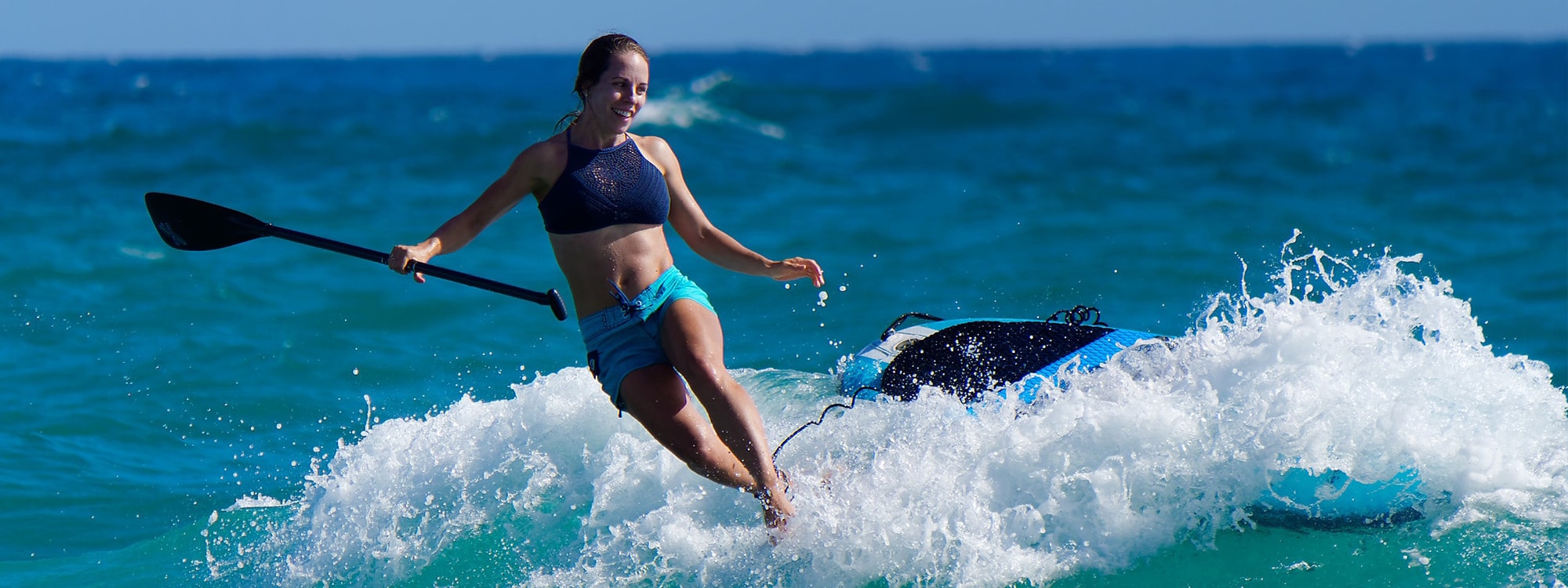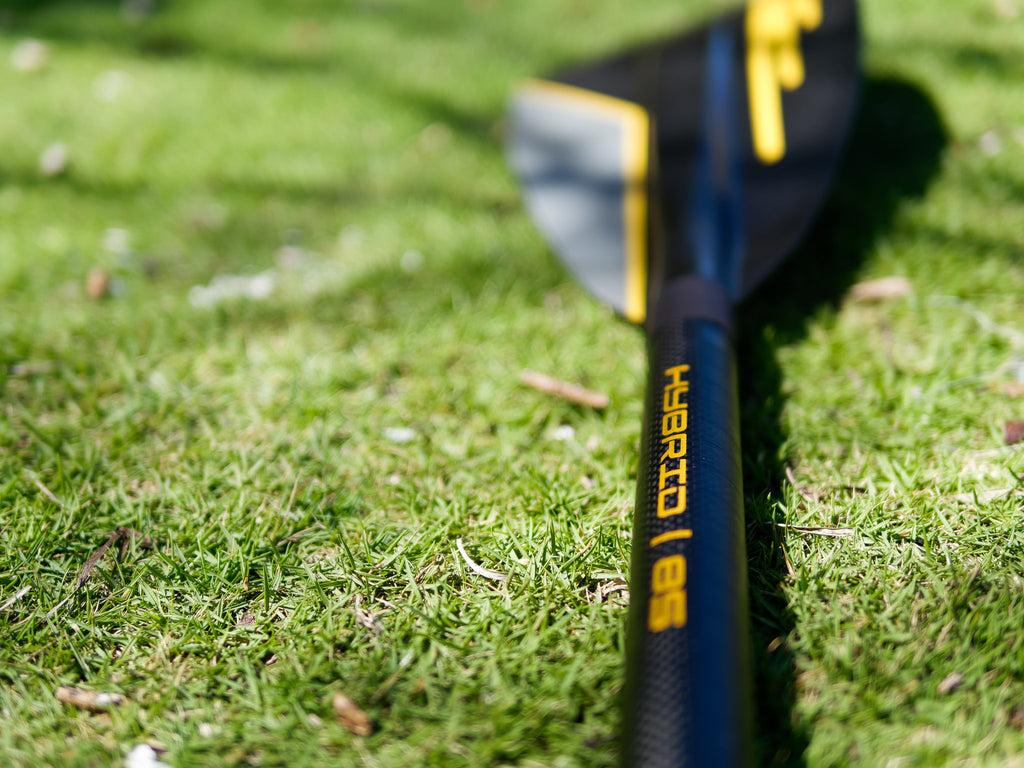
What To Look For In a SUP Paddle
Buying a high performing paddle board and settling for a cheap throw-in paddle is like putting cheap tires on a Ferrari. In the same way that tires transfer the power generated by the engine of your car into motion on the pavement, the SUP paddle is what transfers your body’s energy to the water and moves your board forward. The performance advantages of a great paddle board won’t do much for you if you have a mediocre SUP paddle holding you back.
The average paddler can take up to 1500 strokes in an hour of moderate intensity paddling. Think about what that means in terms of how your paddle affects your paddling experience.
With so many strokes, the comfort of the handle and how it feels in your hand becomes paramount, as does the rigidity of the shaft, the efficiency of the blade, and the overall weight of the paddle.
A low-cost paddle with a few extra ounces of weight may not seem very heavy the first time you pick it up and swing it around, but after your first few hundred strokes, the extra weight becomes a noticeable burden and the benefit of a lighter paddle becomes clear. So it’s definitely worth making sure you’re not selling yourself short by neglecting to consider the comfort, weight, stiffness, and reliability of the paddle as a key component of your SUP kit.
Even paddles that seem similar are often not close to being equal, as a variety of factors significantly affect performance. It often isn't always made clear what you are really buying as there is no naming convention or standard for SUP paddle manufacturing and this is routinely taken advantage of by some manufacturers and retailers.
Let’s look at the essential features and elements of a SUP paddle from the top down and run through the specifications that matter.

The Handle: It’s All About Comfort
The handle is an important determinant of paddling comfort and how it feels in your hand can have a profound effect on your enjoyment of a paddling session.
Cheaper paddles will have a handle made of molded plastic, which is likely to have some rough edges or seams that can cause skin irritation and eventually lead to blisters where they rub on your hands.
For the highest level of paddling comfort, look for a smooth molded carbon handle. The best paddles have the handle integrally molded with the shaft as a single seamless piece, so the entire surface is smooth and there is no glue joint that can come loose over time

Length Adjusting System: Convenience and Reliability Are Key
Most paddles can be adjusted for length by way of a handle mounted on a telescoping section of shaft. What differs between paddle of different qualities and design approaches is how the shaft is secured at the desired length, with some being much better in practice than others.
Hole and Pin Adjusters
Early paddle designs and some current cheaper models have a series of holes near the top of the main shaft and a metal pin in the telescoping handle shaft that snaps into one of the holes to set the paddle length. These can be difficult to operate, and the holes provide a path for water to infiltrate the shaft, which can cause the paddle to sink. We do not recommend paddles with this design.
Plastic Lever Adjustors
A recent trend in paddle design puts the adjusting system in the handle, with a lever that applies tension to a cable which secures the handle shaft to the main shaft at a chosen position. The lever is a piece of plastic that flips open from a cutout in the handle and allows you to slide the shaft up and down.
While we appreciate the cleverness of the design, it has some notable design flaws in real-world use. Our main issue with these systems is that the handle is made of plastic and the cutout for the lever which can be an irritating source of rubbing against the palm of your hand. We have also observed that the cable tends to stretch and loosen over time and is difficult to service when this happens.
Cam Lever Length Adjusters
Based on extensive paddle testing and long term use on the water, we have developed a strong preference for length adjusters that uses a cam lever mounted on the outer shaft. This system is easy to operate, allows for continuous fine adjustment of the paddle length, and does not interfere with the handle in any way. Screws on the shaft fitting allow for easy adjustments to the clamping strength and these can be replaced easily if required.

Interested in buying a performance SUP paddle? - The right paddle will change your paddling experience dramatically! Poor paddle designs are common place but work with us and we're confident we can find the right paddle for you.
An additional feature that we recommend highly is a grooved adjusting shaft that keeps the handle in the proper orientation during adjustment, making it impossible to position the handle backward or at an improper angle.
A frequent question when shopping for a paddle is what length is needed. A good adjustable paddle makes this a moot point, at least for paddlers who are at least 5 feet tall and less than 6’4”. If you are near the high or low end of this range, be sure to check the minimum and maximum length of the paddle before purchasing.

Shaft Choices For Strength, Rigidity, and Weight Savings
Aluminum is generally used on the cheapest paddles, as it is the heaviest of the shaft materials and its only advantage is cost savings, making it a frequent choice as part of a lower cost paddle board kit. Better paddles will have a shaft made from fiberglass, carbon fiber, or a blend of both.
Many mid-range paddles have a blended fiberglass/carbon shaft, which is a practical compromise for moderate weight, good strength, and reasonable affordability.
This is where you will need to pay particular attention to the manufacturers specifications. There is no standard naming convention for SUP paddles in terms of their material composition, so many manufacturers take liberties and will call their paddles 'carbon' without indicating it is a carbon blend and not full carbon.
Carbon Shaft Composition
For the lightest shaft, 100% carbon fiber is the material of choice. As touched on earlier, be aware of how the paddle is described so you know what you are getting.
If it is described as a “carbon shaft” paddle, it is most likely is a fiberglass/carbon blend, which could have as little as 10% carbon content if not specified. Look for more specific descriptors, such as “Full Carbon”, “100% carbon fiber”, or “50% carbon” for an indication of the true carbon content and check the paddle’s weight specification if you are intending to buy an ultra-light carbon fiber paddle.
Carbon fiber comes in a variety of weaves that are used for different strength, weight and cost-saving properties. The appearance of woven fabric on the surface of the shaft is your first clue that carbon fiber was actually used in building the shaft. The inner layers of material that you can’t see will also be carbon in a full carbon or 100% carbon paddle, or they will alternate between fiberglass and carbon in different ratios for a blended shaft.
Fiberglass is actually very strong, it's just heavier. This is why blending fiberglass and carbon is an acceptable design with a reasonable ration of each to balance strength and lightness.
Unfortunately, many of the paddles being sold in mass-market outlets or included in a kit as “carbon” paddles are all fiberglass on the inside, with just an outer layer of carbon for appearances and to justify calling it a “carbon” paddle. You can’t see what’s inside the shaft, so the best indication of the actual carbon content of a paddle is its weight.
Paddle Weight
A true performance carbon paddle should weigh under 25 ounces for a 3 Piece Adjustable paddle with a large carbon blade or under 30 oz for a hybrid paddle with a 50% carbon blend shaft and a plastic/poly blade.
Weights for a smaller blades or 2-Piece or 1-Piece paddle which have fewer parts should be a few ounces lower sans the sans the weight the required joint hardware adds. A carbon paddle weighing over 30oz has very little if any carbon composition and is using a blend, or is using heavier (and cheaper) 6K or 12K carbon base.
Shaft Texture
One last detail to consider is the texture of the shaft, which can be smooth or textured. A completely smooth shaft can be a little slippery in your hands, especially right after a fall when the paddle is wet.
A slightly textured surface can be provided by woven carbon outer surface of the shaft, but only if a glossy or smooth matte coating is not applied.

Blade Material Choices: What Separates High-End Paddles From The Ordinary
The blade is the most critical part of the paddle, as it contributes the most to the performance and swing weight of the paddle, and also to its cost. The most common and affordable blades are made of some type of plastic or composite plastic material, with a smaller number of blades on more expensive paddles made of compressed fiberglass or carbon fiber.
Plastic or Poly Blades
Plastic blades are the most common and have the advantages of keeping the cost of the paddle down and being able to withstand all kinds of abuse. The downside to plastic is its weight, which can make the paddle feel heavy and clunky if not carefully designed to keep it as light as possible while maintaining enough rigidity to not feel flimsy.
When buying a paddle with a plastic blade, be sure to check the total weight of the paddle. Most plastic blade paddles are heavy, but some of the better ones weigh in at less than 30 oz, which is more than a paddle with a carbon blade would weigh, but still much lighter than most of the cheaper “carbon shaft” paddles on the market.
A plastic/poly blade can sometimes make sense for a paddler who hits a lot of rocks and tends to 'bang up' their paddle because carbon and compressed fiberglass can chip or break when smashed against rocks, whereas a plastic/poly blade will just carry on with nothing more than cosmetic imperfection.
Experienced paddlers will often keep a plastic blade paddle in their kit for doing low water whitewater runs or exploring other shallow and rocky places where hitting rocks is unavoidable (or alternatively use a rubber trim to protect the blade edge). However, for the very best SUP experience in most paddling environments, it’s definitely worth investing in a full carbon paddle that has an actual carbon blade, which will make the paddle extremely light and rigid.
Component Materials and Carbon Quality
This is an area where you need to be alert to sales pitches and marketing speak. If all major parts of the paddle, including the handle, shaft, and blade are made of carbon fiber, it can rightfully be called a “full carbon” or “100% carbon” paddle. Carbon blades are very expensive to manufacture, so you’ll only find them on fairly expensive paddles. Many dealers and manufacturers will use the term “carbon paddle” to refer to a paddle with some carbon in the shaft, but a blade made from composite or poly material.
The quality of the carbon is another factor that often isn't disclosed by manufacturers selling cheaper carbon paddles. You can have two paddles of roughly equal size that weigh 25oz vs 30oz+ that are both described as 'full carbon', so it can be difficult to tell the difference if you are not specifically comparing the overall paddle weight.
Cheap carbon paddle blades that use heavier than optimal base materials are not fun to paddle with. Sure they basically look like a 'carbon' paddle but the similarities end there in terms of performance and longevity vs the real thing. Just be sure to look beyond the label and find out the actual carbon content of the paddle, always making sure the weight specification makes sense for the claimed paddle composition.
Blade Size
Finally, blade sizing needs to be considered. The general principle you need to know is that larger blades deliver more power with each stroke but lead to a slower paddling cadence.
Smaller blades move less water with each stroke but lend themselves to taking faster strokes. In the end, blade size has little influence on board speed, as your paddling style will adjust to taking bigger slower strokes or smaller faster strokes, which expend the same amount of energy and provide the similar propulsion.
The sweet spot for blade size is in the 85-95 square inch range, which is ideal for most paddlers. There is no hard and fast rule for choosing a blade size, but heavier paddlers may opt for a larger blade and paddlers with joint issues may find a smaller blade puts less stress on their bodies.

How Many Sections Should My SUP Paddle Have?
SUP paddles come in several shaft configurations, which are designed to find a balance between performance and portability.
3-Piece Paddles
Paddles with three sections are the de facto standard of SUP paddles, especially when used with inflatable SUP boards.
The paddle breaks down into 3 parts of equal or similar length, and this allows you to pack the paddle in your SUP bag or fit it in tight spaces such as the trunk of your car. 3-piece paddles have a telescoping top section which allows adjustment of paddle length to fit the height of the individual paddler.
For 90% of casual to enthusiast paddlers, a 3-piece paddle is the best solution. When entering disciplines such as whitewater, surfing, or racing, a 1- or 2-piece paddle makes more sense to consider, though if you've invested in a quality 3-piece paddle, you always have the option of a great travel paddle for when portability is required.
2-Piece Paddles
2-Piece paddles eliminate the mid-shaft joint found on 3-piece paddles, which adds to the strength of the shaft and reduces the overall weight by a few ounces. The mid-shaft is where much of the flex occurs when taking a stroke, so having a continuous shaft in this area can have a positive effect on the strength and performance of the paddle in more demanding uses.
The telescoping top section of the shaft still allows length adjustment, so this type of paddle can be shared by multiple users of different heights. The disadvantage of the 2-piece paddle is that it is more difficult to travel with, so the majority of casual paddlers often stick with the more convenient 3-piece models.
The two-piece paddle is a favorite with lesson programs and rental outfitters.
1-Piece Paddles
The 1-piece paddle is the gold standard for performance and is a paddle that many will graduate to after a few years of paddling. The length of the paddle is fixed to the user’s height and there are no adjustment mechanisms or joints.
The shaft of a 1-piece paddle must be cut to a specific length, after which the handle is glued in place by the shop or after purchase by the user.
The advantages of a 1-piece paddle are strength and ultimate lightness. A 1-Piece fixed-length paddle is as strong as the shaft material itself and has the minimum weight for a given length and material, making it a great choice when portability and length adjustment are not needed.

Summarized Paddle Buying Checklist
Before you buy a paddle or a SUP package that includes one, be sure to check for the following features:
- Smooth molded carbon handle (generally avoid plastic handles if possible)
- Shaft-mounted cam lever length adjuster (avoid paddles with lever style locking mechanisms that leave a big hole in the handle right where your palm will rest
- Grooved shaft for fixed handle orientation (a nice feature to keep the paddle handle and blade aligned)
- Carbon or carbon blend shaft, paying particular attention to actual carbon content demonstrated by the overall paddle weight.
- Carbon, fiberglass or moderate weight plastic/poly blade, again paying attention to the specific type and quality of the materials. If the composition isn't specifically stated it is often using a blend or sub par base material vs a paddle that specifically states 3K / 100% / Full Carbon construction.
- Total weight less than 30 oz for a plastic blade paddle and less than 25 oz for a 3-Piece full carbon paddle (slightly lower for 1 and 2 piece paddles). Every time you go out for a paddle, you will be taking hundreds to thousands of strokes, so saving some ounces of the weight of your paddle will let you paddle much longer with less fatigue.
- Find the right SUP Paddle for you in our range and contact us for individual advice to suit your SUP paddling needs.

Want Expert Advice on Choosing an Inflatable SUP Board?
Check out our 2025 Inflatable Paddle Board Buying Guide - or - The Best Inflatable Paddle Board - Reality vs the Internet.
Want To Buy an Inflatable SUP Board?
Explore our range of SUP boards for sale by activity / use in Inflatable SUP Type or focus on Inflatable SUP Brands to find the right board for you.
Want Answers to Anything Stand Up Paddle Boarding and Inflatable SUP?
The Pumped Up SUP SUP Paddle Blog is the best resource on the internet for up to date information to help with your next inflatable SUP purchase!




